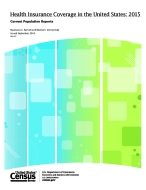Health Insurance Coverage in the United States: 2015
Health Insurance Coverage in the United States: 2015
Report Number: P60-257
Introduction
This report presents statistics on health insurance coverage in the United States based on information collected in the 2014, 2015, and 2016 Current Population Survey Annual Social and Economic Supplements (CPS ASEC) and the American Community Survey (ACS).
User Note
Once a decade, the CPS ASEC transitions to a new sample design and updates all metropolitan statistical area delineations. As a result, the metropolitan/nonmetropolitan estimates for 2014 and 2015 are not comparable. Click below for more information.
Highlights
- The uninsured rate decreased between 2014 and 2015 by 1.3 percentage points as measured by the CPS ASEC. In 2015, the percentage of people without health insurance coverage for the entire calendar year was 9.1 percent, or 29.0 million, lower than the rate and number of uninsured in 2014 (10.4 percent or 33.0 million).
- The percentage of people with health insurance coverage for all or part of 2015 was 90.9 percent, higher than the rate in 2014 (89.6 percent).
- In 2015, private health insurance coverage continued to be more prevalent than public coverage, at 67.2 percent and 37.1 percent, respectively. Of the subtypes of health insurance, employer-based insurance covered 55.7 percent of the population for some or all of the calendar year, followed by Medicaid (19.6 percent), Medicare (16.3 percent), direct-purchase (16.3 percent), and military coverage (4.7 percent).
- Increases in both private health insurance coverage and government coverage contributed to the overall increase in coverage between 2014 and 2015. The rate of private coverage increased by 1.2 percentage points to 67.2 percent in 2015 (up from 66.0 percent in 2014), and the government coverage rate increased by 0.6 percentage points to 37.1 percent (up from 36.5 percent in 2014).
- Between 2014 and 2015, the greatest change in coverage was the change in direct-purchase health insurance, which increased by 1.7 percentage points to cover 16.3 percent of people for some or all of 2015 (up from 14.6 percent in 2014).
- For the second year in a row, the percentage of people without health insurance dropped for every single year of age under 65.
- In 2015, the percentage of uninsured children under age 19 was 5.3 percent. This was a decrease from 6.2 percent in 2014.
- In 2015, the uninsured rate for children under age 19 in poverty, 7.5 percent, was higher than the uninsured rate for children not in poverty, 4.8 percent.
- In 2015, non-Hispanic Whites had the lowest uninsured rate among race and Hispanic origin groups, at 6.7 percent. The uninsured rates for Blacks and Asians were higher than for non-Hispanic Whites, at 11.1 percent and 7.5 percent, respectively. Hispanics had the highest uninsured rate in 2015, at 16.2 percent.
- Between 2014 and 2015, the overall rate of health insurance coverage increased for most race and Hispanic-origin groups. Hispanics had the largest increase (3.6 percentage points), followed by Asians (1.9 percentage points) and non-Hispanic Whites (0.9 percentage points). The Current Population Survey did not measure a statistically significant difference in the health insurance coverage rate for Blacks between 2014 and 2015.
- Between 2014 and 2015, the uninsured rate decreased in 47 states and the District of Columbia. Three states (North Dakota, South Dakota, and Wyoming) did not experience a statistically significant change in their uninsured rate.
Related Blogs
-
Random Samplings BlogAnother Look at Health Insurance Coverage Rates for Young AdultsIn the last half decade, young adults (ages 19 to 25) gained health insurance coverage more than any other age group (Figure 1).
-
Random Samplings BlogHealth Insurance Coverage Measurement in Two SurveysNext week, the U.S. Census Bureau is releasing two important sources for health insurance statistics in the United States: the Annual Social and Economic Supplement to the Current Population Survey and the American Community Survey.
-
Random Samplings BlogTwo Views of the Changes in Health Insurance Rates From 2008 to 2015Today, the U.S. Census Bureau is releasing a tool to look at the history of health insurance coverage in the United States: an animated map showing changes in uninsured rates by state, going back to 2008.
Tables
Health Insurance Detailed Tables
-
TableCurrent Population Survey Tables for Health Insurance CoverageThe Current Population Survey is a joint effort between the Bureau of Labor Statistics and the Census Bureau.
-
TableAmerican Community Survey Tables for Health Insurance CoverageThese tables present data on state-level health insurance coverage in the United States.
Source & Accuracy
CPS ASEC Research Files
Current Coverage
Press Release
Others in Series
Publication
Custodial Mothers and Fathers and Their Child Support: 2013
This report focuses on the child support income that custodial parents reported receiving from noncustodial parents living elsewhere and other types of support.
Publication
Income and Poverty in the United States: 2015
This report presents data on income, earnings, income inequality & poverty in the United States based on information collected in the 2015 and earlier CPS ASEC.
Publication
The Supplemental Poverty Measure: 2015
This is the sixth report describing research on the Supplemental Poverty Measure (SPM).
Page Last Revised - April 24, 2024






